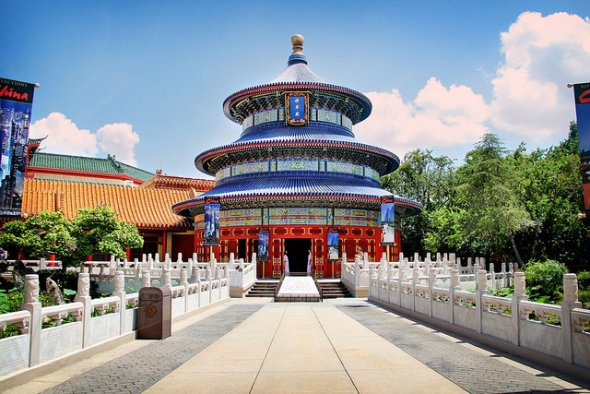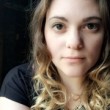The FBI kept tabs on the construction and staffing of the China pavilion.
Image: Lucas Possiede, Flickr (license)
The World Showcase is easily Epcot’s most unique and breathtaking feature. Its 11 pavilions span North American, European, Asian, North African, and Latin American countries, among several others, allowing guests to sample the cultures, architectures, and cuisines of places and peoples all around the world. While today’s pavilions symbolize an ongoing hope for unity and peaceful international relations, there were those who had serious reservations about the project during its inception—most notably, the Federal Bureau of Investigation.
Before we get to the hows and whys of the FBI’s involvement in Epcot, however, let’s take a look at the formation of the World Showcase. After all, Disney didn’t come up with their list of initial participants—Mexico, China, Germany, Italy, the American Adventure (United States), Japan, France, the United Kingdom, and Canada—on a whim. According to Walt Disney Productions’ 1975 Annual Report (excerpted by Warner Weiss), the showcase offered countries the opportunity to set up (permanent) shop in Disney’s new theme park, with whatever manner of restaurants, shops, entertainment, and attractions they deemed most fitting… or had the most capital to provide. Disney also noted that participating countries would be required to staff and house their own employees, not unlike the requirements previously established at world’s fairs. Organizing and staffing a temporary exhibition was one thing, however—providing the funds and employees for a permanent, year-round pavilion was quite another.
It should have come as little surprise to Disney that few countries were willing to make such a sizable investment. Until the opening of the Morocco pavilion in 1984, no national governments agreed to fund their country’s pavilion, leaving it up to private businesses (or, in some cases, Disney alone) to kick in some cash. The American Adventure pavilion’s original sponsors included American Express and Coca Cola, for instance, while Mexico had Moctezuma Brewery and San Angel Inn, the United Kingdom had Bass Export Ltd., Pringle of Scotland, and Royal Doulton, and so on. In the years that followed Epcot’s 1982 debut, rumors of additional pavilions—Israel, Spain, Equatorial Africa, Denmark, Iran, Poland, Yugoslavia, Switzerland, United Arab Emirates, Costa Rica, Brazil, the Netherlands, and Russia—quickly sprouted and withered as Disney failed to procure additional sponsors or take on the costs of construction and staffing themselves.
For other countries, it wasn’t a matter of coughing up the money for a pavilion, but of navigating a fraught relationship with the United States itself. In 2016, MuckRock’s Jason Smauthers uncovered FBI documents pertaining to the surveillance of Epcot’s construction—documents that revealed the government had been keeping a watchful eye over Disney’s partnerships with foreign countries as they attempted to attract sponsorships for their new project.
In one report dated December 1979, the FBI noted that the Soviet Union had engaged in preliminary talks with Disney two years prior before they were ultimately dissuaded from financing a pavilion. According to the report, WDW officials made it clear that no participating country could use the World Showcase to make a political statement, which ended up being a clear “turn-off” for the Soviet government. It doesn’t appear that many other countries entertained the same idea—at least, they didn’t admit so publicly—but as Epcot’s grand opening drew closer and closer, more red flags were raised.
While a Soviet Union pavilion never seemed to move past the initial stages of discussion, a China pavilion was soon developed as one of the World Showcase’s original nine stations. Like every other pavilion in Epcot, it would also be staffed by several young foreign delegates, all of whom were initially expected to take up residence in Disney-provided housing in Kissimmee. It was enough to send the Bureau into a tailspin. Partially redacted reports revealed that the FBI feared the People’s Republic of China had the means and intention of purchasing their own segregated communal housing for staffers, though exactly what they imagined the delegates would get up to there is unclear. Nevertheless, the Bureau kept meticulous notes on each of the pavilion’s original six staff members: tracking alleged thefts from the shops, sick leave requests, work hours, performance reports, even personality quirks in their attempts to detect any unusual behavior.
After several years of monitoring the China pavilion, nothing substantive turned up (or, if it did, it was carefully omitted from any documents the FBI publicly released). Additional fears, not concerning interference from the Chinese government, but rather that of international terrorist groups infiltrating multiple points in Epcot’s World Showcase, proved equally unfounded. Disney had opened its doors to the world, so to speak, and it appeared that they would fulfill at least part of the vision of unity and progress the company spoke to in 1975: “An on-going international exposition, […] the World Showcase will communicate the culture, heritage, history, technology, trade, tourism and future goals of the participating nations.”


Add new comment